Revolutionizing Employee Recruitment: The Role of Internet and IT
VerifiedAdded on 2023/06/03
|13
|3676
|51
Essay
AI Summary
This essay examines the profound impact of the internet and information technology (IT) on employee recruitment processes within Human Resource Management (HRM). It begins by defining HRM and its evolving role in organizations, highlighting the shift from administrative tasks to strategic functions. The paper discusses both internal and external factors influencing HR management, with a specific focus on technology, globalization, and changing workforce demographics. It elaborates on the advantages of the internet, such as increased accessibility to the global marketplace, mobile internet access, and the globalization of supply chains. Social media's benefits, including customer base creation and targeted advertising, are also explored. Furthermore, the essay delves into how AI, IoT, and Industry 5.0 are reshaping recruitment, enabling faster, unbiased candidate screening and enhancing communication through AI chatbots. Finally, it emphasizes the advantages of using IT and the internet in recruitment, such as increased productivity and reduced operational costs, while also acknowledging the importance of social media platforms in evaluating prospective candidates.
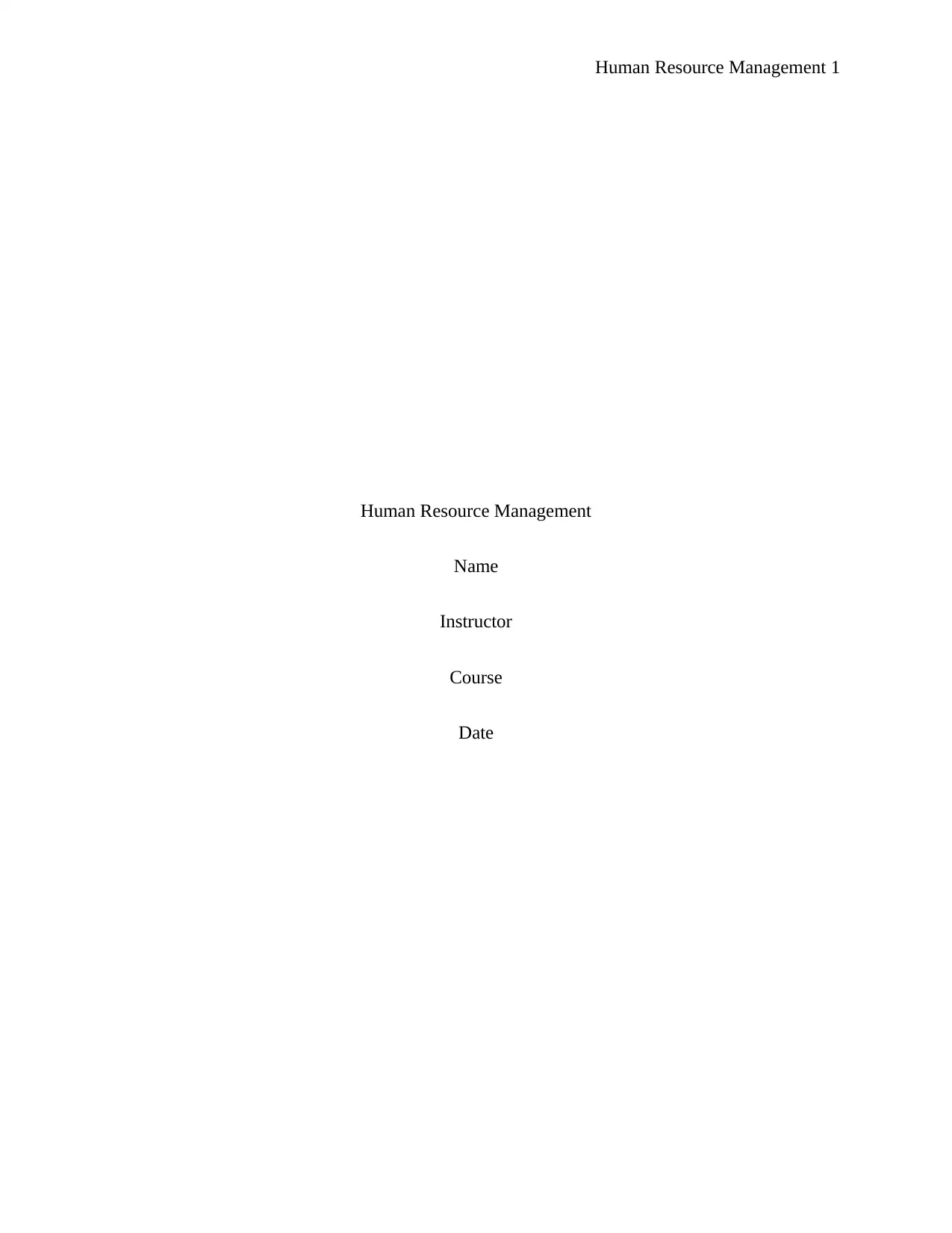
Human Resource Management 1
Human Resource Management
Name
Instructor
Course
Date
Human Resource Management
Name
Instructor
Course
Date
Paraphrase This Document
Need a fresh take? Get an instant paraphrase of this document with our AI Paraphraser
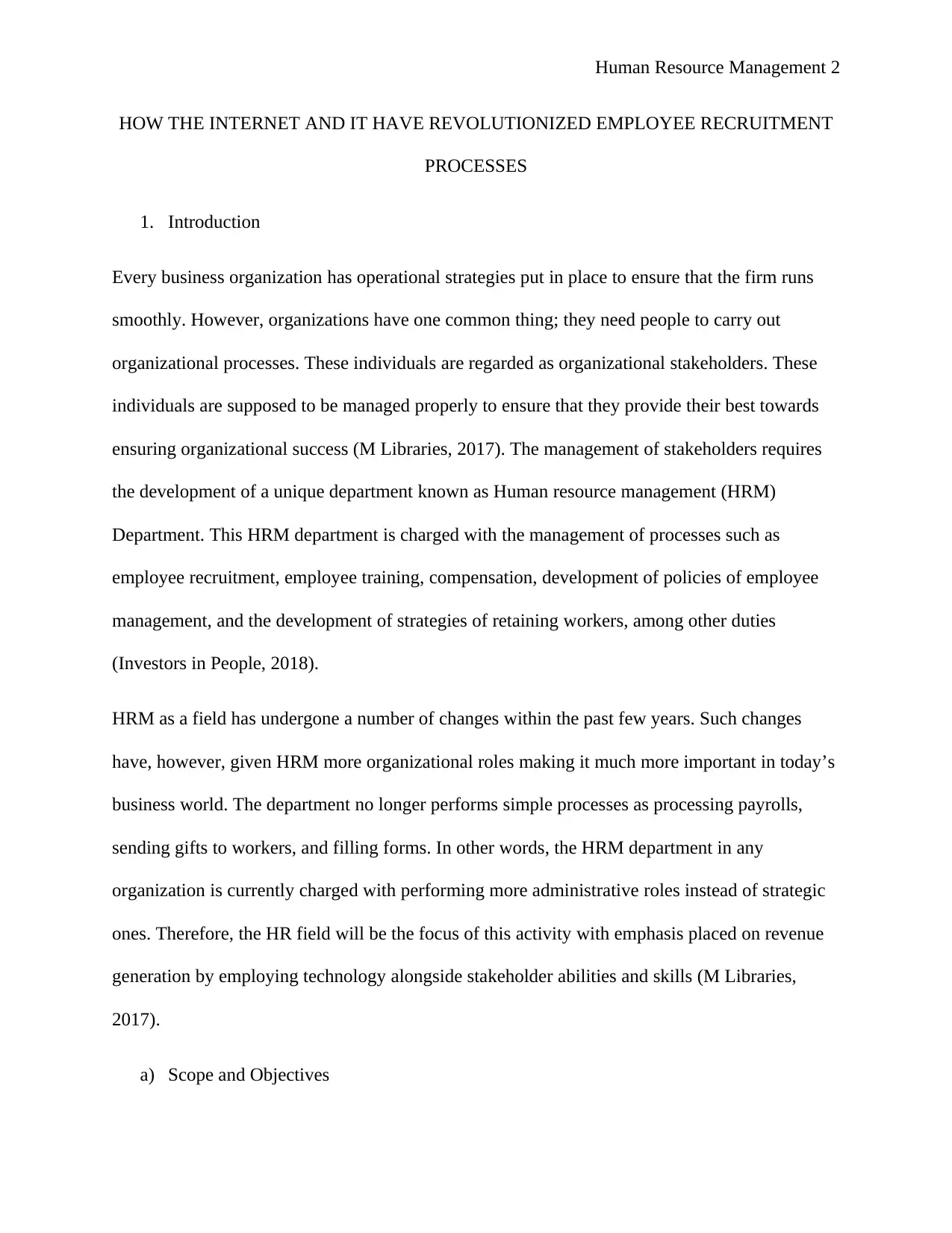
Human Resource Management 2
HOW THE INTERNET AND IT HAVE REVOLUTIONIZED EMPLOYEE RECRUITMENT
PROCESSES
1. Introduction
Every business organization has operational strategies put in place to ensure that the firm runs
smoothly. However, organizations have one common thing; they need people to carry out
organizational processes. These individuals are regarded as organizational stakeholders. These
individuals are supposed to be managed properly to ensure that they provide their best towards
ensuring organizational success (M Libraries, 2017). The management of stakeholders requires
the development of a unique department known as Human resource management (HRM)
Department. This HRM department is charged with the management of processes such as
employee recruitment, employee training, compensation, development of policies of employee
management, and the development of strategies of retaining workers, among other duties
(Investors in People, 2018).
HRM as a field has undergone a number of changes within the past few years. Such changes
have, however, given HRM more organizational roles making it much more important in today’s
business world. The department no longer performs simple processes as processing payrolls,
sending gifts to workers, and filling forms. In other words, the HRM department in any
organization is currently charged with performing more administrative roles instead of strategic
ones. Therefore, the HR field will be the focus of this activity with emphasis placed on revenue
generation by employing technology alongside stakeholder abilities and skills (M Libraries,
2017).
a) Scope and Objectives
HOW THE INTERNET AND IT HAVE REVOLUTIONIZED EMPLOYEE RECRUITMENT
PROCESSES
1. Introduction
Every business organization has operational strategies put in place to ensure that the firm runs
smoothly. However, organizations have one common thing; they need people to carry out
organizational processes. These individuals are regarded as organizational stakeholders. These
individuals are supposed to be managed properly to ensure that they provide their best towards
ensuring organizational success (M Libraries, 2017). The management of stakeholders requires
the development of a unique department known as Human resource management (HRM)
Department. This HRM department is charged with the management of processes such as
employee recruitment, employee training, compensation, development of policies of employee
management, and the development of strategies of retaining workers, among other duties
(Investors in People, 2018).
HRM as a field has undergone a number of changes within the past few years. Such changes
have, however, given HRM more organizational roles making it much more important in today’s
business world. The department no longer performs simple processes as processing payrolls,
sending gifts to workers, and filling forms. In other words, the HRM department in any
organization is currently charged with performing more administrative roles instead of strategic
ones. Therefore, the HR field will be the focus of this activity with emphasis placed on revenue
generation by employing technology alongside stakeholder abilities and skills (M Libraries,
2017).
a) Scope and Objectives
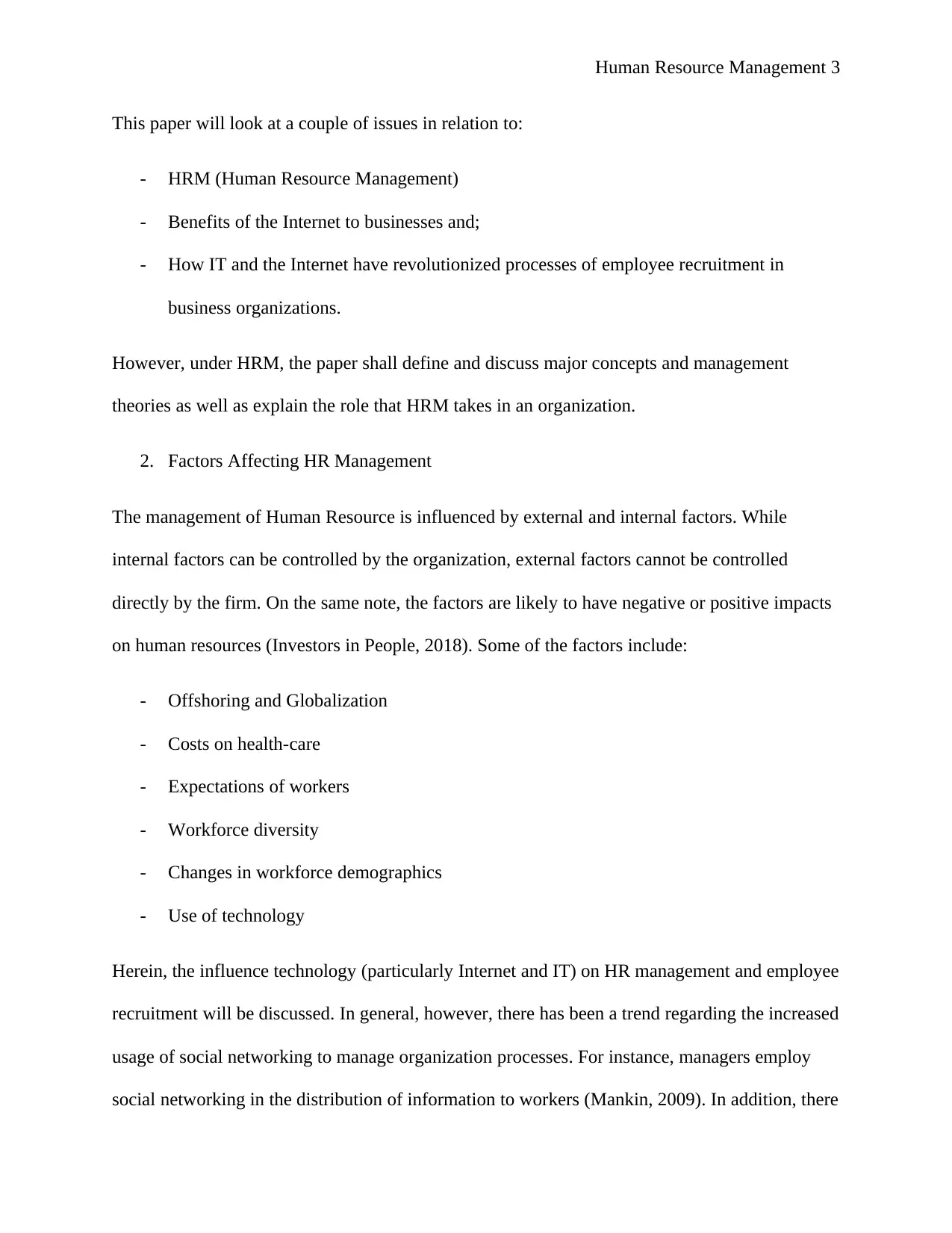
Human Resource Management 3
This paper will look at a couple of issues in relation to:
- HRM (Human Resource Management)
- Benefits of the Internet to businesses and;
- How IT and the Internet have revolutionized processes of employee recruitment in
business organizations.
However, under HRM, the paper shall define and discuss major concepts and management
theories as well as explain the role that HRM takes in an organization.
2. Factors Affecting HR Management
The management of Human Resource is influenced by external and internal factors. While
internal factors can be controlled by the organization, external factors cannot be controlled
directly by the firm. On the same note, the factors are likely to have negative or positive impacts
on human resources (Investors in People, 2018). Some of the factors include:
- Offshoring and Globalization
- Costs on health-care
- Expectations of workers
- Workforce diversity
- Changes in workforce demographics
- Use of technology
Herein, the influence technology (particularly Internet and IT) on HR management and employee
recruitment will be discussed. In general, however, there has been a trend regarding the increased
usage of social networking to manage organization processes. For instance, managers employ
social networking in the distribution of information to workers (Mankin, 2009). In addition, there
This paper will look at a couple of issues in relation to:
- HRM (Human Resource Management)
- Benefits of the Internet to businesses and;
- How IT and the Internet have revolutionized processes of employee recruitment in
business organizations.
However, under HRM, the paper shall define and discuss major concepts and management
theories as well as explain the role that HRM takes in an organization.
2. Factors Affecting HR Management
The management of Human Resource is influenced by external and internal factors. While
internal factors can be controlled by the organization, external factors cannot be controlled
directly by the firm. On the same note, the factors are likely to have negative or positive impacts
on human resources (Investors in People, 2018). Some of the factors include:
- Offshoring and Globalization
- Costs on health-care
- Expectations of workers
- Workforce diversity
- Changes in workforce demographics
- Use of technology
Herein, the influence technology (particularly Internet and IT) on HR management and employee
recruitment will be discussed. In general, however, there has been a trend regarding the increased
usage of social networking to manage organization processes. For instance, managers employ
social networking in the distribution of information to workers (Mankin, 2009). In addition, there
⊘ This is a preview!⊘
Do you want full access?
Subscribe today to unlock all pages.

Trusted by 1+ million students worldwide
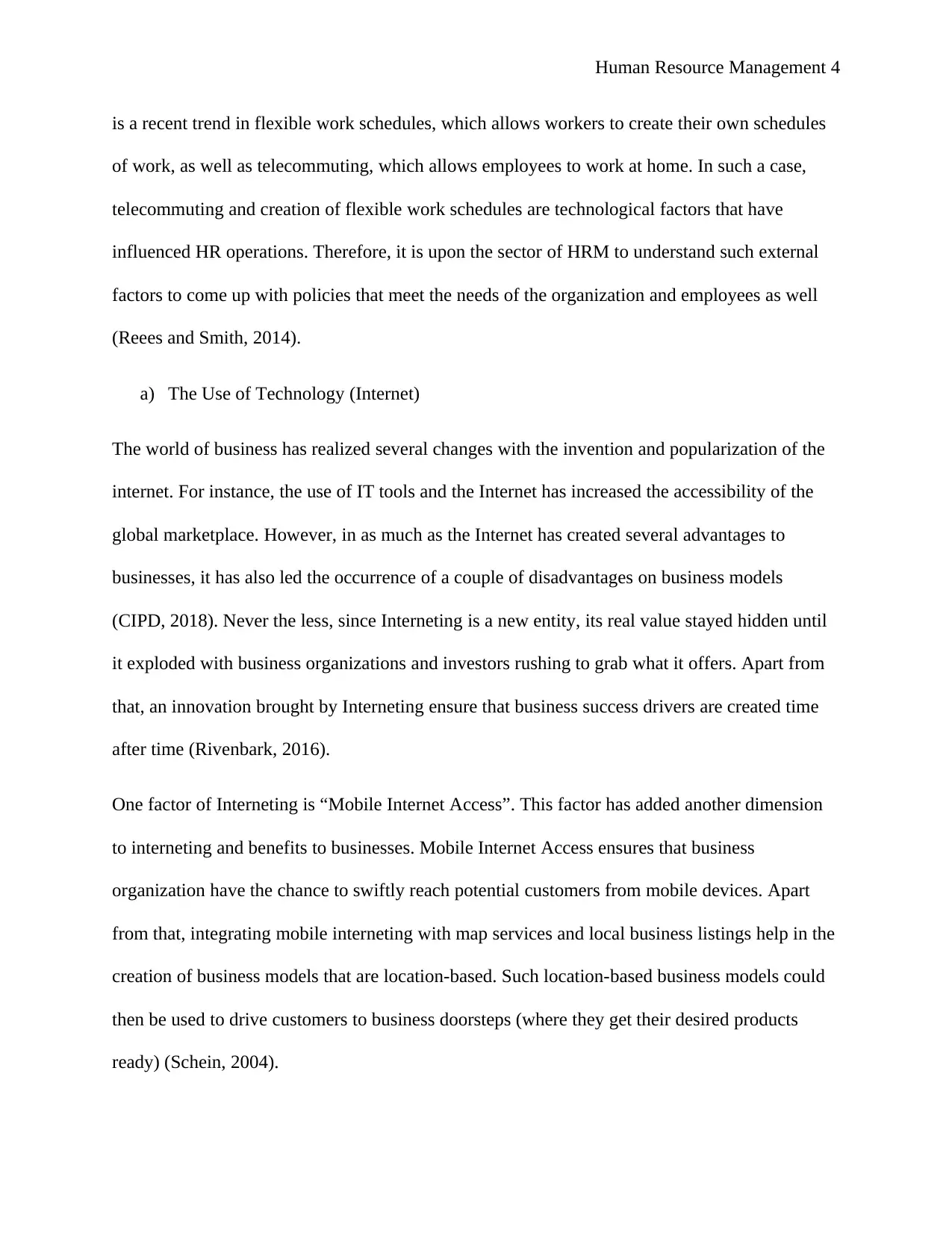
Human Resource Management 4
is a recent trend in flexible work schedules, which allows workers to create their own schedules
of work, as well as telecommuting, which allows employees to work at home. In such a case,
telecommuting and creation of flexible work schedules are technological factors that have
influenced HR operations. Therefore, it is upon the sector of HRM to understand such external
factors to come up with policies that meet the needs of the organization and employees as well
(Reees and Smith, 2014).
a) The Use of Technology (Internet)
The world of business has realized several changes with the invention and popularization of the
internet. For instance, the use of IT tools and the Internet has increased the accessibility of the
global marketplace. However, in as much as the Internet has created several advantages to
businesses, it has also led the occurrence of a couple of disadvantages on business models
(CIPD, 2018). Never the less, since Interneting is a new entity, its real value stayed hidden until
it exploded with business organizations and investors rushing to grab what it offers. Apart from
that, an innovation brought by Interneting ensure that business success drivers are created time
after time (Rivenbark, 2016).
One factor of Interneting is “Mobile Internet Access”. This factor has added another dimension
to interneting and benefits to businesses. Mobile Internet Access ensures that business
organization have the chance to swiftly reach potential customers from mobile devices. Apart
from that, integrating mobile interneting with map services and local business listings help in the
creation of business models that are location-based. Such location-based business models could
then be used to drive customers to business doorsteps (where they get their desired products
ready) (Schein, 2004).
is a recent trend in flexible work schedules, which allows workers to create their own schedules
of work, as well as telecommuting, which allows employees to work at home. In such a case,
telecommuting and creation of flexible work schedules are technological factors that have
influenced HR operations. Therefore, it is upon the sector of HRM to understand such external
factors to come up with policies that meet the needs of the organization and employees as well
(Reees and Smith, 2014).
a) The Use of Technology (Internet)
The world of business has realized several changes with the invention and popularization of the
internet. For instance, the use of IT tools and the Internet has increased the accessibility of the
global marketplace. However, in as much as the Internet has created several advantages to
businesses, it has also led the occurrence of a couple of disadvantages on business models
(CIPD, 2018). Never the less, since Interneting is a new entity, its real value stayed hidden until
it exploded with business organizations and investors rushing to grab what it offers. Apart from
that, an innovation brought by Interneting ensure that business success drivers are created time
after time (Rivenbark, 2016).
One factor of Interneting is “Mobile Internet Access”. This factor has added another dimension
to interneting and benefits to businesses. Mobile Internet Access ensures that business
organization have the chance to swiftly reach potential customers from mobile devices. Apart
from that, integrating mobile interneting with map services and local business listings help in the
creation of business models that are location-based. Such location-based business models could
then be used to drive customers to business doorsteps (where they get their desired products
ready) (Schein, 2004).
Paraphrase This Document
Need a fresh take? Get an instant paraphrase of this document with our AI Paraphraser
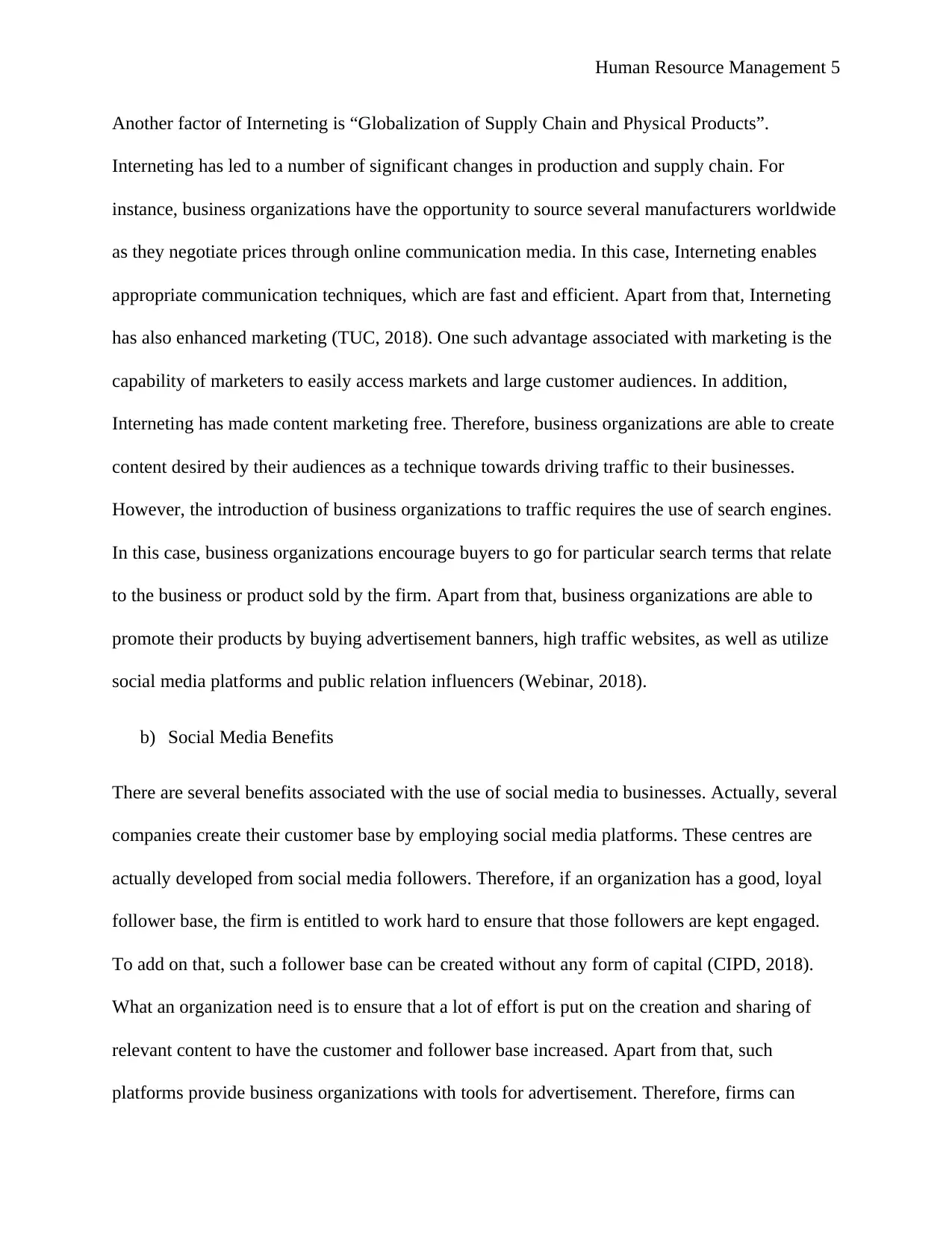
Human Resource Management 5
Another factor of Interneting is “Globalization of Supply Chain and Physical Products”.
Interneting has led to a number of significant changes in production and supply chain. For
instance, business organizations have the opportunity to source several manufacturers worldwide
as they negotiate prices through online communication media. In this case, Interneting enables
appropriate communication techniques, which are fast and efficient. Apart from that, Interneting
has also enhanced marketing (TUC, 2018). One such advantage associated with marketing is the
capability of marketers to easily access markets and large customer audiences. In addition,
Interneting has made content marketing free. Therefore, business organizations are able to create
content desired by their audiences as a technique towards driving traffic to their businesses.
However, the introduction of business organizations to traffic requires the use of search engines.
In this case, business organizations encourage buyers to go for particular search terms that relate
to the business or product sold by the firm. Apart from that, business organizations are able to
promote their products by buying advertisement banners, high traffic websites, as well as utilize
social media platforms and public relation influencers (Webinar, 2018).
b) Social Media Benefits
There are several benefits associated with the use of social media to businesses. Actually, several
companies create their customer base by employing social media platforms. These centres are
actually developed from social media followers. Therefore, if an organization has a good, loyal
follower base, the firm is entitled to work hard to ensure that those followers are kept engaged.
To add on that, such a follower base can be created without any form of capital (CIPD, 2018).
What an organization need is to ensure that a lot of effort is put on the creation and sharing of
relevant content to have the customer and follower base increased. Apart from that, such
platforms provide business organizations with tools for advertisement. Therefore, firms can
Another factor of Interneting is “Globalization of Supply Chain and Physical Products”.
Interneting has led to a number of significant changes in production and supply chain. For
instance, business organizations have the opportunity to source several manufacturers worldwide
as they negotiate prices through online communication media. In this case, Interneting enables
appropriate communication techniques, which are fast and efficient. Apart from that, Interneting
has also enhanced marketing (TUC, 2018). One such advantage associated with marketing is the
capability of marketers to easily access markets and large customer audiences. In addition,
Interneting has made content marketing free. Therefore, business organizations are able to create
content desired by their audiences as a technique towards driving traffic to their businesses.
However, the introduction of business organizations to traffic requires the use of search engines.
In this case, business organizations encourage buyers to go for particular search terms that relate
to the business or product sold by the firm. Apart from that, business organizations are able to
promote their products by buying advertisement banners, high traffic websites, as well as utilize
social media platforms and public relation influencers (Webinar, 2018).
b) Social Media Benefits
There are several benefits associated with the use of social media to businesses. Actually, several
companies create their customer base by employing social media platforms. These centres are
actually developed from social media followers. Therefore, if an organization has a good, loyal
follower base, the firm is entitled to work hard to ensure that those followers are kept engaged.
To add on that, such a follower base can be created without any form of capital (CIPD, 2018).
What an organization need is to ensure that a lot of effort is put on the creation and sharing of
relevant content to have the customer and follower base increased. Apart from that, such
platforms provide business organizations with tools for advertisement. Therefore, firms can
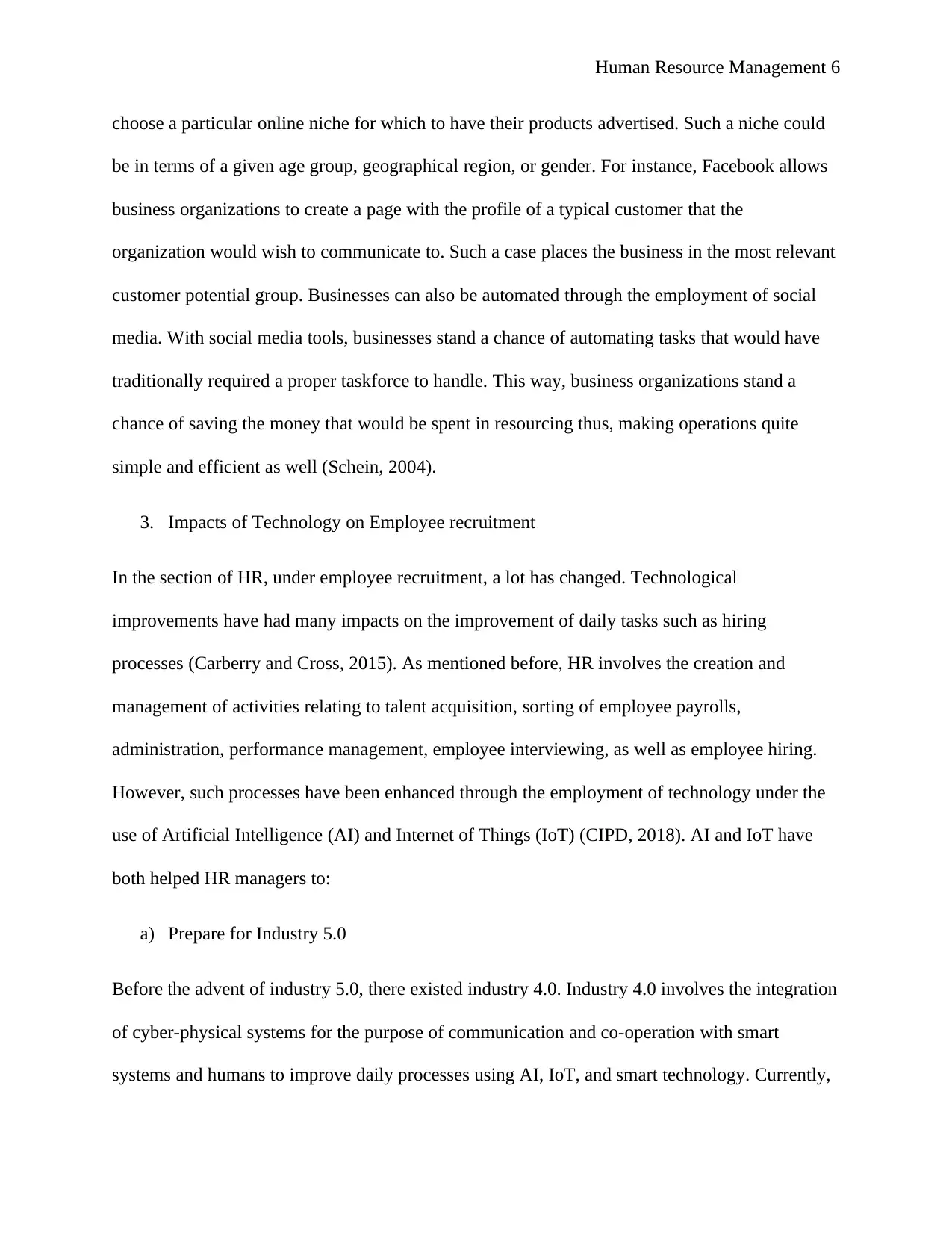
Human Resource Management 6
choose a particular online niche for which to have their products advertised. Such a niche could
be in terms of a given age group, geographical region, or gender. For instance, Facebook allows
business organizations to create a page with the profile of a typical customer that the
organization would wish to communicate to. Such a case places the business in the most relevant
customer potential group. Businesses can also be automated through the employment of social
media. With social media tools, businesses stand a chance of automating tasks that would have
traditionally required a proper taskforce to handle. This way, business organizations stand a
chance of saving the money that would be spent in resourcing thus, making operations quite
simple and efficient as well (Schein, 2004).
3. Impacts of Technology on Employee recruitment
In the section of HR, under employee recruitment, a lot has changed. Technological
improvements have had many impacts on the improvement of daily tasks such as hiring
processes (Carberry and Cross, 2015). As mentioned before, HR involves the creation and
management of activities relating to talent acquisition, sorting of employee payrolls,
administration, performance management, employee interviewing, as well as employee hiring.
However, such processes have been enhanced through the employment of technology under the
use of Artificial Intelligence (AI) and Internet of Things (IoT) (CIPD, 2018). AI and IoT have
both helped HR managers to:
a) Prepare for Industry 5.0
Before the advent of industry 5.0, there existed industry 4.0. Industry 4.0 involves the integration
of cyber-physical systems for the purpose of communication and co-operation with smart
systems and humans to improve daily processes using AI, IoT, and smart technology. Currently,
choose a particular online niche for which to have their products advertised. Such a niche could
be in terms of a given age group, geographical region, or gender. For instance, Facebook allows
business organizations to create a page with the profile of a typical customer that the
organization would wish to communicate to. Such a case places the business in the most relevant
customer potential group. Businesses can also be automated through the employment of social
media. With social media tools, businesses stand a chance of automating tasks that would have
traditionally required a proper taskforce to handle. This way, business organizations stand a
chance of saving the money that would be spent in resourcing thus, making operations quite
simple and efficient as well (Schein, 2004).
3. Impacts of Technology on Employee recruitment
In the section of HR, under employee recruitment, a lot has changed. Technological
improvements have had many impacts on the improvement of daily tasks such as hiring
processes (Carberry and Cross, 2015). As mentioned before, HR involves the creation and
management of activities relating to talent acquisition, sorting of employee payrolls,
administration, performance management, employee interviewing, as well as employee hiring.
However, such processes have been enhanced through the employment of technology under the
use of Artificial Intelligence (AI) and Internet of Things (IoT) (CIPD, 2018). AI and IoT have
both helped HR managers to:
a) Prepare for Industry 5.0
Before the advent of industry 5.0, there existed industry 4.0. Industry 4.0 involves the integration
of cyber-physical systems for the purpose of communication and co-operation with smart
systems and humans to improve daily processes using AI, IoT, and smart technology. Currently,
⊘ This is a preview!⊘
Do you want full access?
Subscribe today to unlock all pages.

Trusted by 1+ million students worldwide
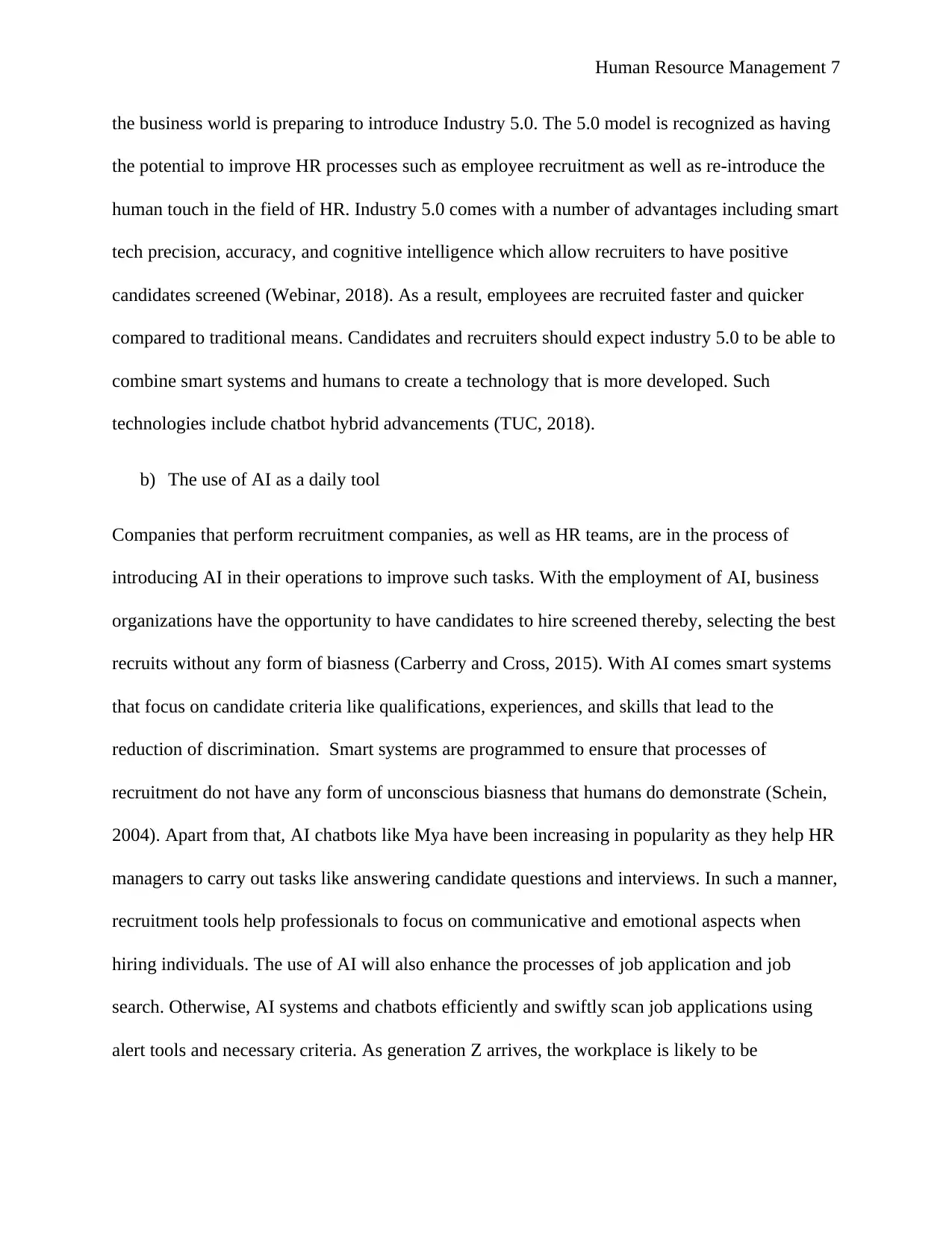
Human Resource Management 7
the business world is preparing to introduce Industry 5.0. The 5.0 model is recognized as having
the potential to improve HR processes such as employee recruitment as well as re-introduce the
human touch in the field of HR. Industry 5.0 comes with a number of advantages including smart
tech precision, accuracy, and cognitive intelligence which allow recruiters to have positive
candidates screened (Webinar, 2018). As a result, employees are recruited faster and quicker
compared to traditional means. Candidates and recruiters should expect industry 5.0 to be able to
combine smart systems and humans to create a technology that is more developed. Such
technologies include chatbot hybrid advancements (TUC, 2018).
b) The use of AI as a daily tool
Companies that perform recruitment companies, as well as HR teams, are in the process of
introducing AI in their operations to improve such tasks. With the employment of AI, business
organizations have the opportunity to have candidates to hire screened thereby, selecting the best
recruits without any form of biasness (Carberry and Cross, 2015). With AI comes smart systems
that focus on candidate criteria like qualifications, experiences, and skills that lead to the
reduction of discrimination. Smart systems are programmed to ensure that processes of
recruitment do not have any form of unconscious biasness that humans do demonstrate (Schein,
2004). Apart from that, AI chatbots like Mya have been increasing in popularity as they help HR
managers to carry out tasks like answering candidate questions and interviews. In such a manner,
recruitment tools help professionals to focus on communicative and emotional aspects when
hiring individuals. The use of AI will also enhance the processes of job application and job
search. Otherwise, AI systems and chatbots efficiently and swiftly scan job applications using
alert tools and necessary criteria. As generation Z arrives, the workplace is likely to be
the business world is preparing to introduce Industry 5.0. The 5.0 model is recognized as having
the potential to improve HR processes such as employee recruitment as well as re-introduce the
human touch in the field of HR. Industry 5.0 comes with a number of advantages including smart
tech precision, accuracy, and cognitive intelligence which allow recruiters to have positive
candidates screened (Webinar, 2018). As a result, employees are recruited faster and quicker
compared to traditional means. Candidates and recruiters should expect industry 5.0 to be able to
combine smart systems and humans to create a technology that is more developed. Such
technologies include chatbot hybrid advancements (TUC, 2018).
b) The use of AI as a daily tool
Companies that perform recruitment companies, as well as HR teams, are in the process of
introducing AI in their operations to improve such tasks. With the employment of AI, business
organizations have the opportunity to have candidates to hire screened thereby, selecting the best
recruits without any form of biasness (Carberry and Cross, 2015). With AI comes smart systems
that focus on candidate criteria like qualifications, experiences, and skills that lead to the
reduction of discrimination. Smart systems are programmed to ensure that processes of
recruitment do not have any form of unconscious biasness that humans do demonstrate (Schein,
2004). Apart from that, AI chatbots like Mya have been increasing in popularity as they help HR
managers to carry out tasks like answering candidate questions and interviews. In such a manner,
recruitment tools help professionals to focus on communicative and emotional aspects when
hiring individuals. The use of AI will also enhance the processes of job application and job
search. Otherwise, AI systems and chatbots efficiently and swiftly scan job applications using
alert tools and necessary criteria. As generation Z arrives, the workplace is likely to be
Paraphrase This Document
Need a fresh take? Get an instant paraphrase of this document with our AI Paraphraser
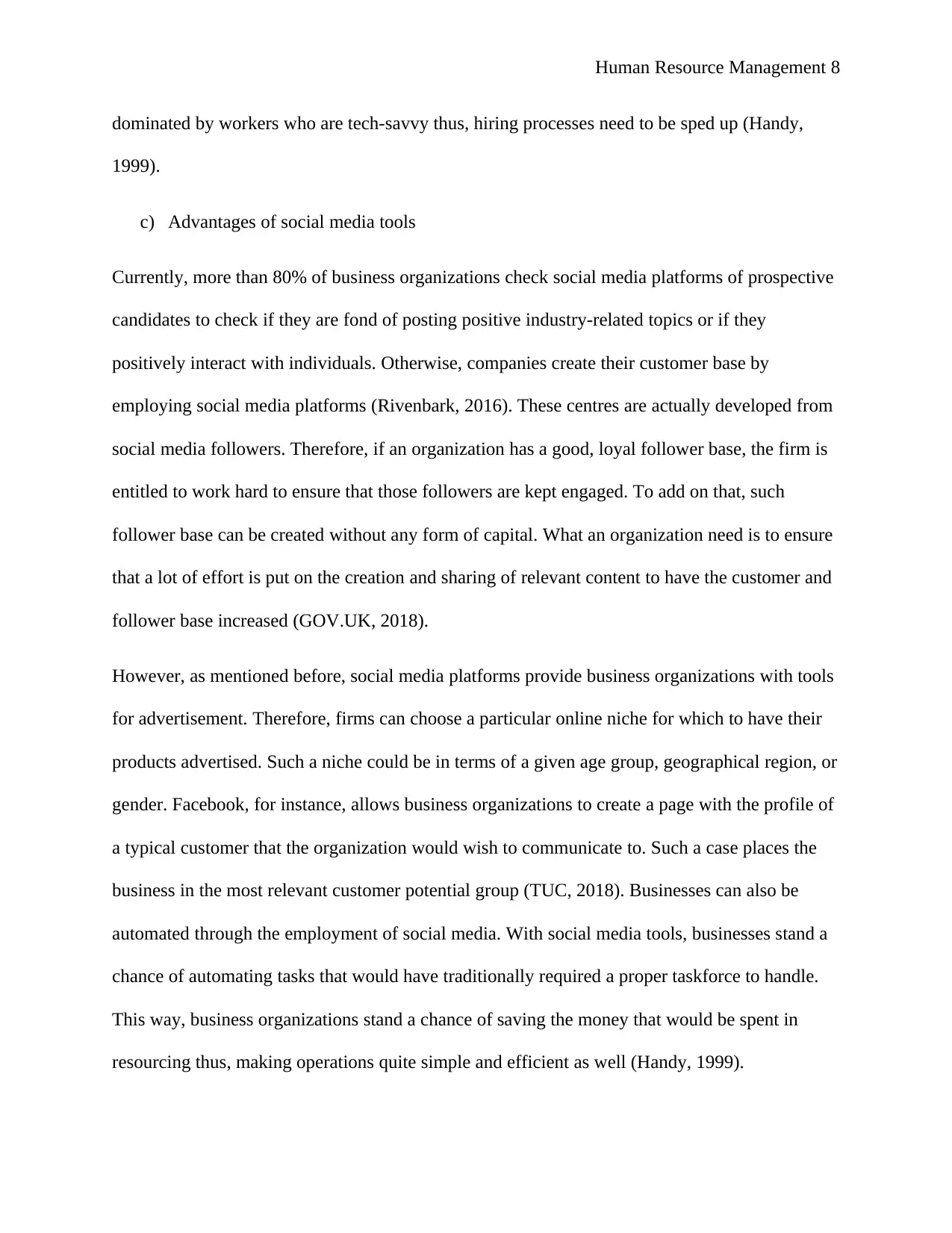
Human Resource Management 8
dominated by workers who are tech-savvy thus, hiring processes need to be sped up (Handy,
1999).
c) Advantages of social media tools
Currently, more than 80% of business organizations check social media platforms of prospective
candidates to check if they are fond of posting positive industry-related topics or if they
positively interact with individuals. Otherwise, companies create their customer base by
employing social media platforms (Rivenbark, 2016). These centres are actually developed from
social media followers. Therefore, if an organization has a good, loyal follower base, the firm is
entitled to work hard to ensure that those followers are kept engaged. To add on that, such
follower base can be created without any form of capital. What an organization need is to ensure
that a lot of effort is put on the creation and sharing of relevant content to have the customer and
follower base increased (GOV.UK, 2018).
However, as mentioned before, social media platforms provide business organizations with tools
for advertisement. Therefore, firms can choose a particular online niche for which to have their
products advertised. Such a niche could be in terms of a given age group, geographical region, or
gender. Facebook, for instance, allows business organizations to create a page with the profile of
a typical customer that the organization would wish to communicate to. Such a case places the
business in the most relevant customer potential group (TUC, 2018). Businesses can also be
automated through the employment of social media. With social media tools, businesses stand a
chance of automating tasks that would have traditionally required a proper taskforce to handle.
This way, business organizations stand a chance of saving the money that would be spent in
resourcing thus, making operations quite simple and efficient as well (Handy, 1999).
dominated by workers who are tech-savvy thus, hiring processes need to be sped up (Handy,
1999).
c) Advantages of social media tools
Currently, more than 80% of business organizations check social media platforms of prospective
candidates to check if they are fond of posting positive industry-related topics or if they
positively interact with individuals. Otherwise, companies create their customer base by
employing social media platforms (Rivenbark, 2016). These centres are actually developed from
social media followers. Therefore, if an organization has a good, loyal follower base, the firm is
entitled to work hard to ensure that those followers are kept engaged. To add on that, such
follower base can be created without any form of capital. What an organization need is to ensure
that a lot of effort is put on the creation and sharing of relevant content to have the customer and
follower base increased (GOV.UK, 2018).
However, as mentioned before, social media platforms provide business organizations with tools
for advertisement. Therefore, firms can choose a particular online niche for which to have their
products advertised. Such a niche could be in terms of a given age group, geographical region, or
gender. Facebook, for instance, allows business organizations to create a page with the profile of
a typical customer that the organization would wish to communicate to. Such a case places the
business in the most relevant customer potential group (TUC, 2018). Businesses can also be
automated through the employment of social media. With social media tools, businesses stand a
chance of automating tasks that would have traditionally required a proper taskforce to handle.
This way, business organizations stand a chance of saving the money that would be spent in
resourcing thus, making operations quite simple and efficient as well (Handy, 1999).
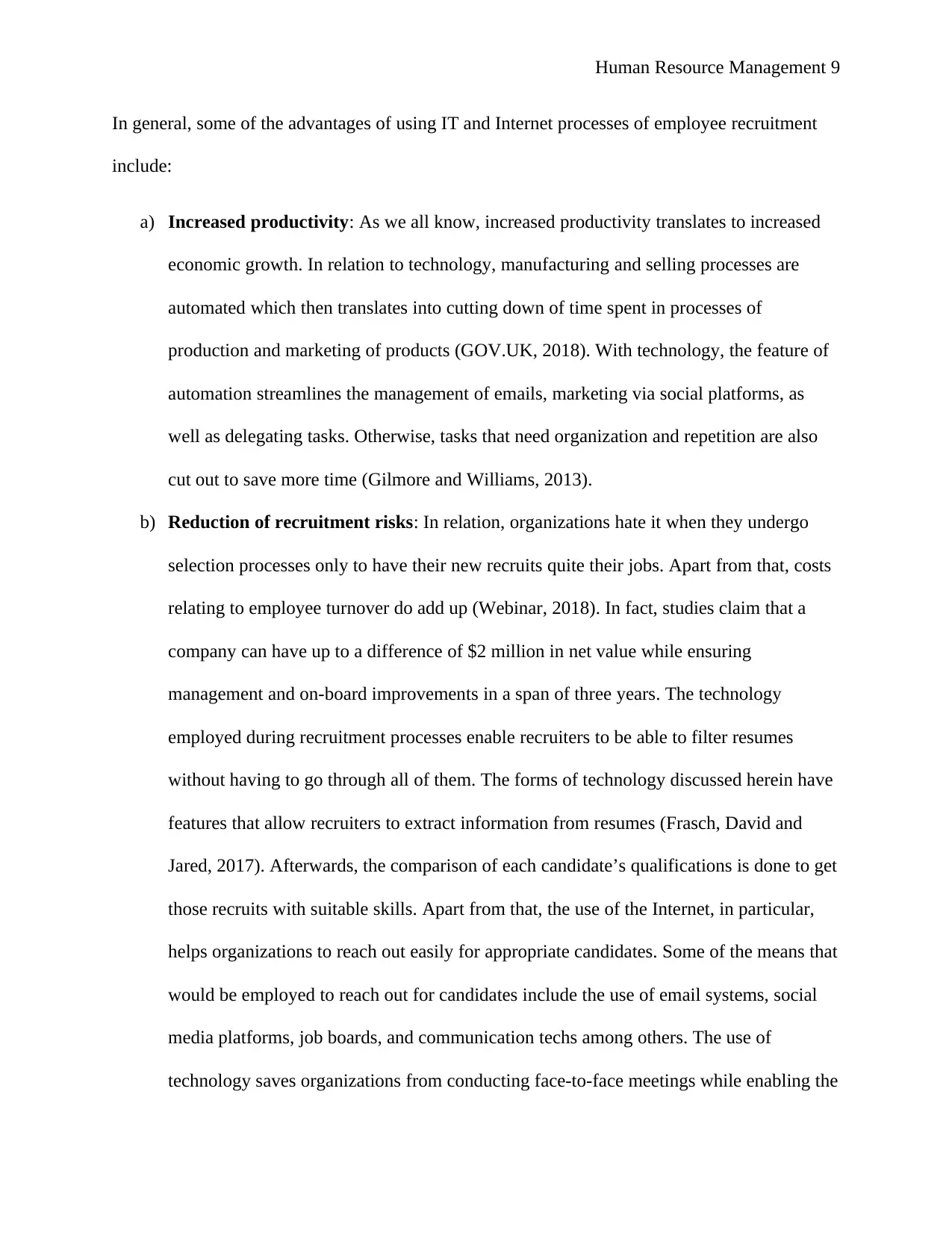
Human Resource Management 9
In general, some of the advantages of using IT and Internet processes of employee recruitment
include:
a) Increased productivity: As we all know, increased productivity translates to increased
economic growth. In relation to technology, manufacturing and selling processes are
automated which then translates into cutting down of time spent in processes of
production and marketing of products (GOV.UK, 2018). With technology, the feature of
automation streamlines the management of emails, marketing via social platforms, as
well as delegating tasks. Otherwise, tasks that need organization and repetition are also
cut out to save more time (Gilmore and Williams, 2013).
b) Reduction of recruitment risks: In relation, organizations hate it when they undergo
selection processes only to have their new recruits quite their jobs. Apart from that, costs
relating to employee turnover do add up (Webinar, 2018). In fact, studies claim that a
company can have up to a difference of $2 million in net value while ensuring
management and on-board improvements in a span of three years. The technology
employed during recruitment processes enable recruiters to be able to filter resumes
without having to go through all of them. The forms of technology discussed herein have
features that allow recruiters to extract information from resumes (Frasch, David and
Jared, 2017). Afterwards, the comparison of each candidate’s qualifications is done to get
those recruits with suitable skills. Apart from that, the use of the Internet, in particular,
helps organizations to reach out easily for appropriate candidates. Some of the means that
would be employed to reach out for candidates include the use of email systems, social
media platforms, job boards, and communication techs among others. The use of
technology saves organizations from conducting face-to-face meetings while enabling the
In general, some of the advantages of using IT and Internet processes of employee recruitment
include:
a) Increased productivity: As we all know, increased productivity translates to increased
economic growth. In relation to technology, manufacturing and selling processes are
automated which then translates into cutting down of time spent in processes of
production and marketing of products (GOV.UK, 2018). With technology, the feature of
automation streamlines the management of emails, marketing via social platforms, as
well as delegating tasks. Otherwise, tasks that need organization and repetition are also
cut out to save more time (Gilmore and Williams, 2013).
b) Reduction of recruitment risks: In relation, organizations hate it when they undergo
selection processes only to have their new recruits quite their jobs. Apart from that, costs
relating to employee turnover do add up (Webinar, 2018). In fact, studies claim that a
company can have up to a difference of $2 million in net value while ensuring
management and on-board improvements in a span of three years. The technology
employed during recruitment processes enable recruiters to be able to filter resumes
without having to go through all of them. The forms of technology discussed herein have
features that allow recruiters to extract information from resumes (Frasch, David and
Jared, 2017). Afterwards, the comparison of each candidate’s qualifications is done to get
those recruits with suitable skills. Apart from that, the use of the Internet, in particular,
helps organizations to reach out easily for appropriate candidates. Some of the means that
would be employed to reach out for candidates include the use of email systems, social
media platforms, job boards, and communication techs among others. The use of
technology saves organizations from conducting face-to-face meetings while enabling the
⊘ This is a preview!⊘
Do you want full access?
Subscribe today to unlock all pages.

Trusted by 1+ million students worldwide
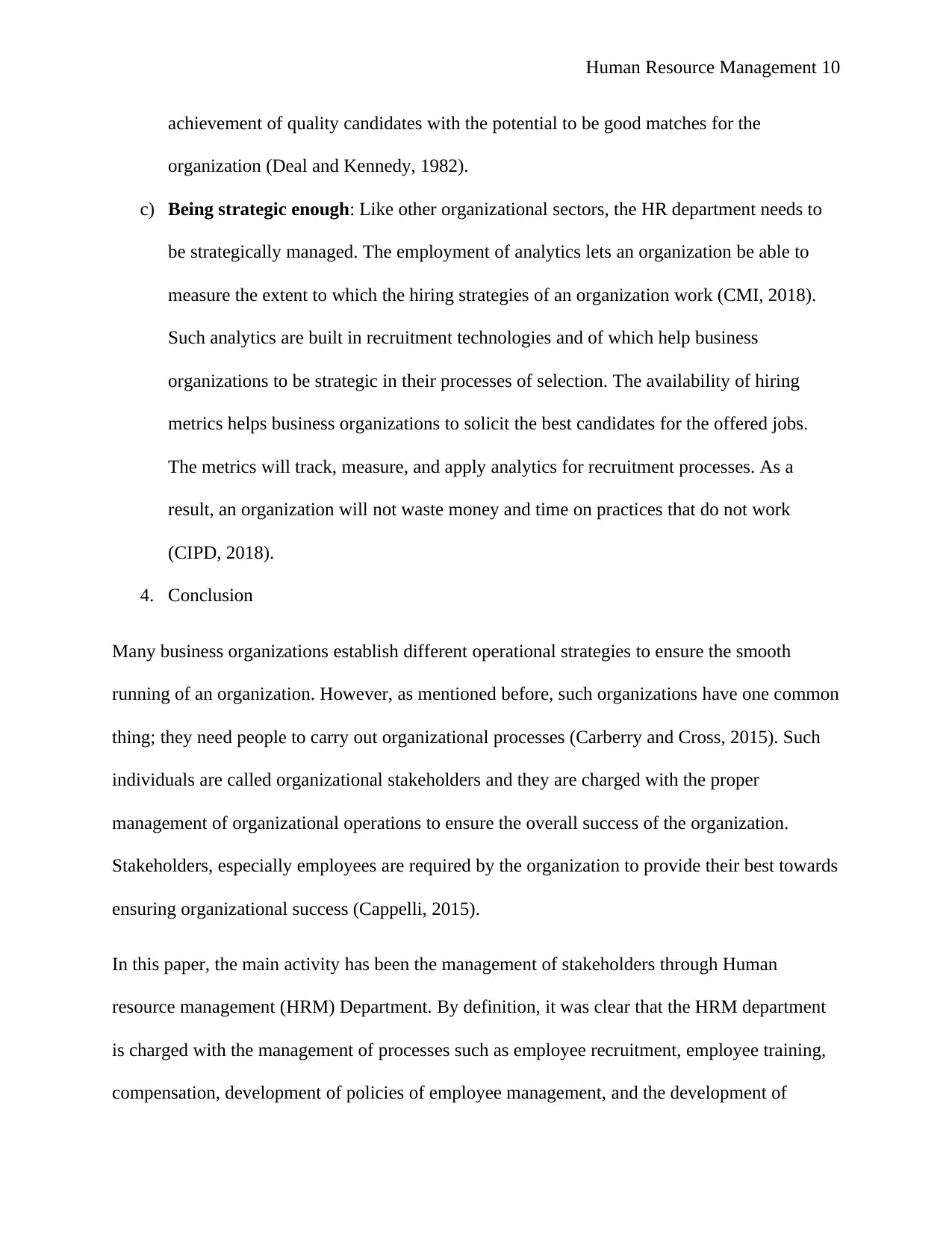
Human Resource Management 10
achievement of quality candidates with the potential to be good matches for the
organization (Deal and Kennedy, 1982).
c) Being strategic enough: Like other organizational sectors, the HR department needs to
be strategically managed. The employment of analytics lets an organization be able to
measure the extent to which the hiring strategies of an organization work (CMI, 2018).
Such analytics are built in recruitment technologies and of which help business
organizations to be strategic in their processes of selection. The availability of hiring
metrics helps business organizations to solicit the best candidates for the offered jobs.
The metrics will track, measure, and apply analytics for recruitment processes. As a
result, an organization will not waste money and time on practices that do not work
(CIPD, 2018).
4. Conclusion
Many business organizations establish different operational strategies to ensure the smooth
running of an organization. However, as mentioned before, such organizations have one common
thing; they need people to carry out organizational processes (Carberry and Cross, 2015). Such
individuals are called organizational stakeholders and they are charged with the proper
management of organizational operations to ensure the overall success of the organization.
Stakeholders, especially employees are required by the organization to provide their best towards
ensuring organizational success (Cappelli, 2015).
In this paper, the main activity has been the management of stakeholders through Human
resource management (HRM) Department. By definition, it was clear that the HRM department
is charged with the management of processes such as employee recruitment, employee training,
compensation, development of policies of employee management, and the development of
achievement of quality candidates with the potential to be good matches for the
organization (Deal and Kennedy, 1982).
c) Being strategic enough: Like other organizational sectors, the HR department needs to
be strategically managed. The employment of analytics lets an organization be able to
measure the extent to which the hiring strategies of an organization work (CMI, 2018).
Such analytics are built in recruitment technologies and of which help business
organizations to be strategic in their processes of selection. The availability of hiring
metrics helps business organizations to solicit the best candidates for the offered jobs.
The metrics will track, measure, and apply analytics for recruitment processes. As a
result, an organization will not waste money and time on practices that do not work
(CIPD, 2018).
4. Conclusion
Many business organizations establish different operational strategies to ensure the smooth
running of an organization. However, as mentioned before, such organizations have one common
thing; they need people to carry out organizational processes (Carberry and Cross, 2015). Such
individuals are called organizational stakeholders and they are charged with the proper
management of organizational operations to ensure the overall success of the organization.
Stakeholders, especially employees are required by the organization to provide their best towards
ensuring organizational success (Cappelli, 2015).
In this paper, the main activity has been the management of stakeholders through Human
resource management (HRM) Department. By definition, it was clear that the HRM department
is charged with the management of processes such as employee recruitment, employee training,
compensation, development of policies of employee management, and the development of
Paraphrase This Document
Need a fresh take? Get an instant paraphrase of this document with our AI Paraphraser
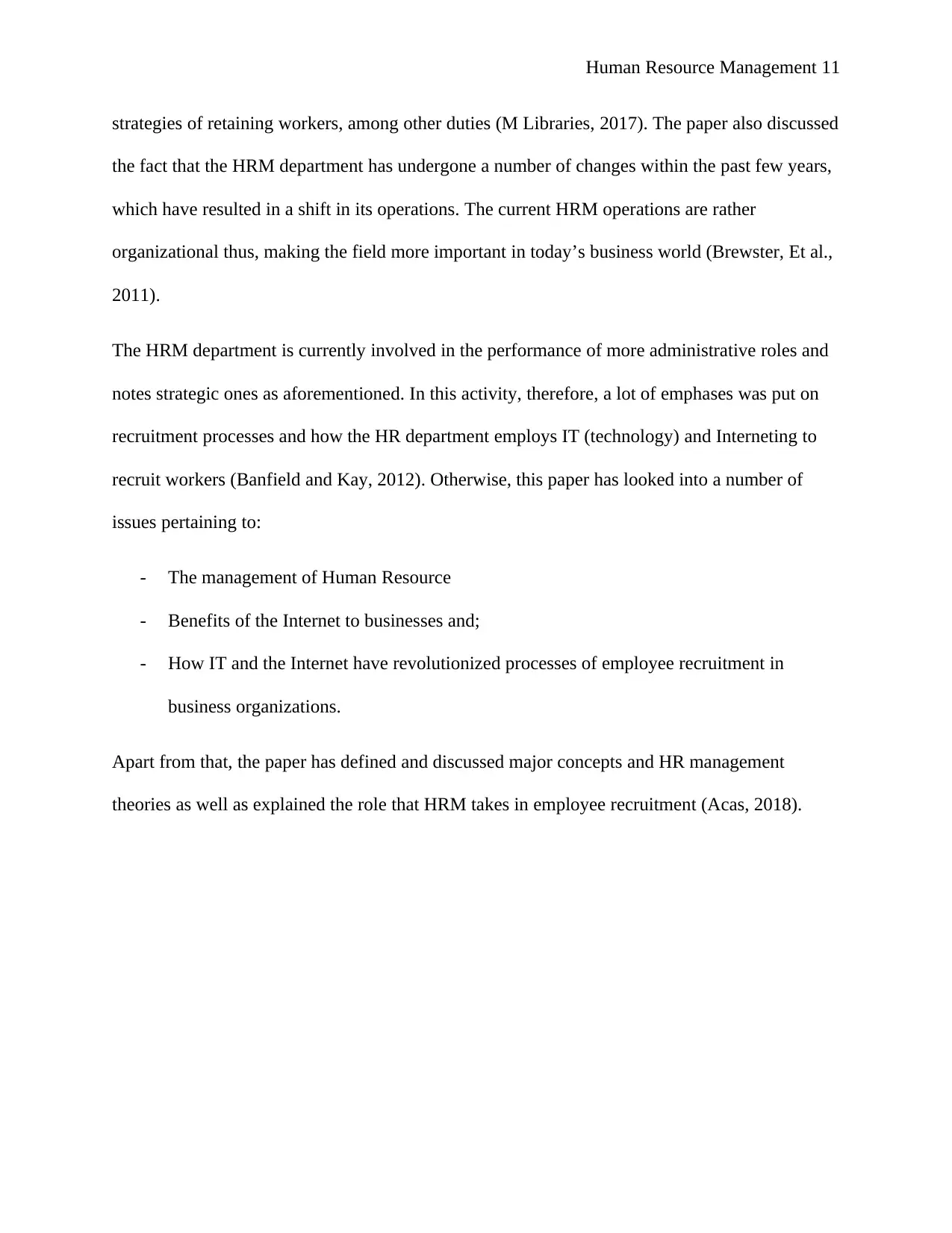
Human Resource Management 11
strategies of retaining workers, among other duties (M Libraries, 2017). The paper also discussed
the fact that the HRM department has undergone a number of changes within the past few years,
which have resulted in a shift in its operations. The current HRM operations are rather
organizational thus, making the field more important in today’s business world (Brewster, Et al.,
2011).
The HRM department is currently involved in the performance of more administrative roles and
notes strategic ones as aforementioned. In this activity, therefore, a lot of emphases was put on
recruitment processes and how the HR department employs IT (technology) and Interneting to
recruit workers (Banfield and Kay, 2012). Otherwise, this paper has looked into a number of
issues pertaining to:
- The management of Human Resource
- Benefits of the Internet to businesses and;
- How IT and the Internet have revolutionized processes of employee recruitment in
business organizations.
Apart from that, the paper has defined and discussed major concepts and HR management
theories as well as explained the role that HRM takes in employee recruitment (Acas, 2018).
strategies of retaining workers, among other duties (M Libraries, 2017). The paper also discussed
the fact that the HRM department has undergone a number of changes within the past few years,
which have resulted in a shift in its operations. The current HRM operations are rather
organizational thus, making the field more important in today’s business world (Brewster, Et al.,
2011).
The HRM department is currently involved in the performance of more administrative roles and
notes strategic ones as aforementioned. In this activity, therefore, a lot of emphases was put on
recruitment processes and how the HR department employs IT (technology) and Interneting to
recruit workers (Banfield and Kay, 2012). Otherwise, this paper has looked into a number of
issues pertaining to:
- The management of Human Resource
- Benefits of the Internet to businesses and;
- How IT and the Internet have revolutionized processes of employee recruitment in
business organizations.
Apart from that, the paper has defined and discussed major concepts and HR management
theories as well as explained the role that HRM takes in employee recruitment (Acas, 2018).
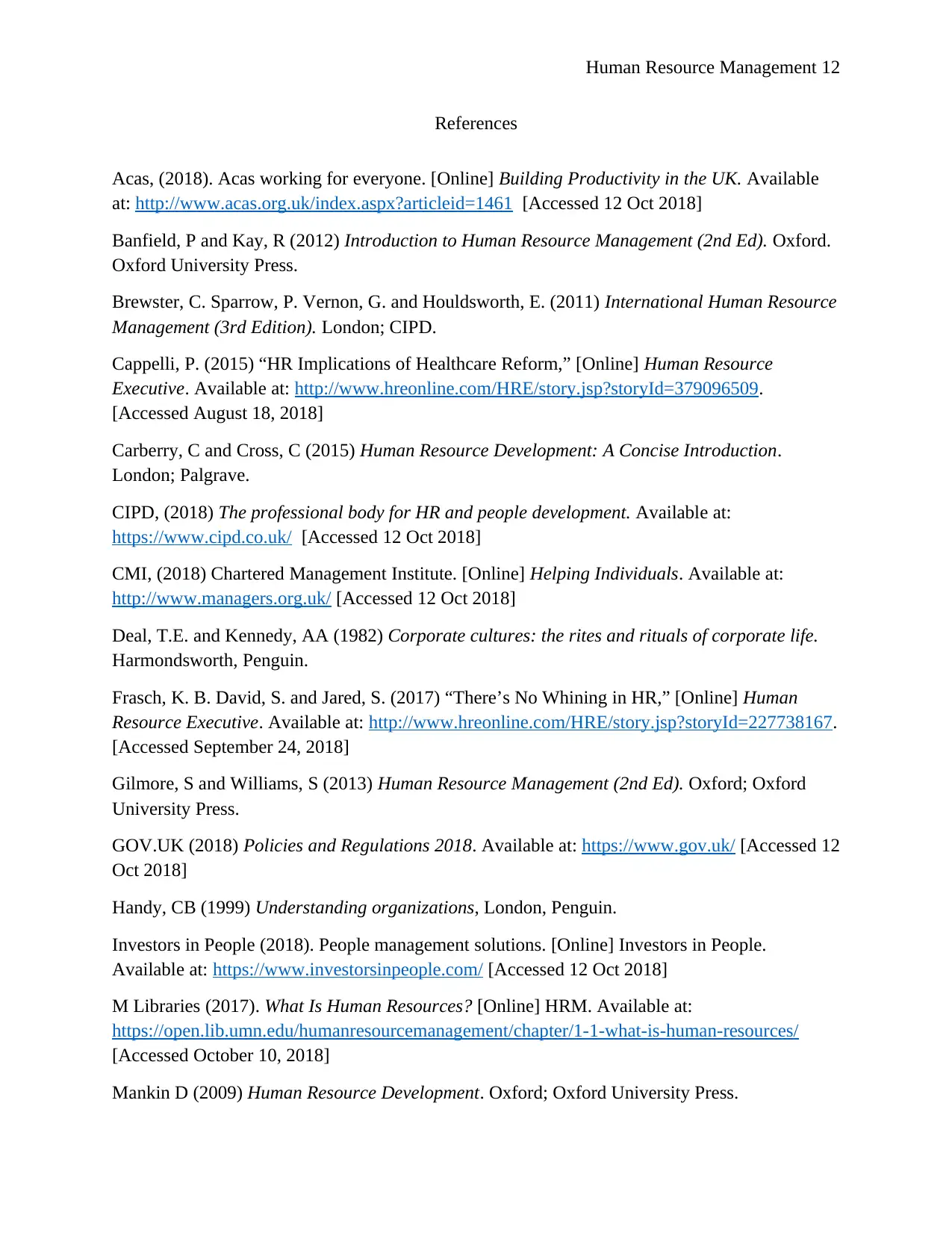
Human Resource Management 12
References
Acas, (2018). Acas working for everyone. [Online] Building Productivity in the UK. Available
at: http://www.acas.org.uk/index.aspx?articleid=1461 [Accessed 12 Oct 2018]
Banfield, P and Kay, R (2012) Introduction to Human Resource Management (2nd Ed). Oxford.
Oxford University Press.
Brewster, C. Sparrow, P. Vernon, G. and Houldsworth, E. (2011) International Human Resource
Management (3rd Edition). London; CIPD.
Cappelli, P. (2015) “HR Implications of Healthcare Reform,” [Online] Human Resource
Executive. Available at: http://www.hreonline.com/HRE/story.jsp?storyId=379096509.
[Accessed August 18, 2018]
Carberry, C and Cross, C (2015) Human Resource Development: A Concise Introduction.
London; Palgrave.
CIPD, (2018) The professional body for HR and people development. Available at:
https://www.cipd.co.uk/ [Accessed 12 Oct 2018]
CMI, (2018) Chartered Management Institute. [Online] Helping Individuals. Available at:
http://www.managers.org.uk/ [Accessed 12 Oct 2018]
Deal, T.E. and Kennedy, AA (1982) Corporate cultures: the rites and rituals of corporate life.
Harmondsworth, Penguin.
Frasch, K. B. David, S. and Jared, S. (2017) “There’s No Whining in HR,” [Online] Human
Resource Executive. Available at: http://www.hreonline.com/HRE/story.jsp?storyId=227738167.
[Accessed September 24, 2018]
Gilmore, S and Williams, S (2013) Human Resource Management (2nd Ed). Oxford; Oxford
University Press.
GOV.UK (2018) Policies and Regulations 2018. Available at: https://www.gov.uk/ [Accessed 12
Oct 2018]
Handy, CB (1999) Understanding organizations, London, Penguin.
Investors in People (2018). People management solutions. [Online] Investors in People.
Available at: https://www.investorsinpeople.com/ [Accessed 12 Oct 2018]
M Libraries (2017). What Is Human Resources? [Online] HRM. Available at:
https://open.lib.umn.edu/humanresourcemanagement/chapter/1-1-what-is-human-resources/
[Accessed October 10, 2018]
Mankin D (2009) Human Resource Development. Oxford; Oxford University Press.
References
Acas, (2018). Acas working for everyone. [Online] Building Productivity in the UK. Available
at: http://www.acas.org.uk/index.aspx?articleid=1461 [Accessed 12 Oct 2018]
Banfield, P and Kay, R (2012) Introduction to Human Resource Management (2nd Ed). Oxford.
Oxford University Press.
Brewster, C. Sparrow, P. Vernon, G. and Houldsworth, E. (2011) International Human Resource
Management (3rd Edition). London; CIPD.
Cappelli, P. (2015) “HR Implications of Healthcare Reform,” [Online] Human Resource
Executive. Available at: http://www.hreonline.com/HRE/story.jsp?storyId=379096509.
[Accessed August 18, 2018]
Carberry, C and Cross, C (2015) Human Resource Development: A Concise Introduction.
London; Palgrave.
CIPD, (2018) The professional body for HR and people development. Available at:
https://www.cipd.co.uk/ [Accessed 12 Oct 2018]
CMI, (2018) Chartered Management Institute. [Online] Helping Individuals. Available at:
http://www.managers.org.uk/ [Accessed 12 Oct 2018]
Deal, T.E. and Kennedy, AA (1982) Corporate cultures: the rites and rituals of corporate life.
Harmondsworth, Penguin.
Frasch, K. B. David, S. and Jared, S. (2017) “There’s No Whining in HR,” [Online] Human
Resource Executive. Available at: http://www.hreonline.com/HRE/story.jsp?storyId=227738167.
[Accessed September 24, 2018]
Gilmore, S and Williams, S (2013) Human Resource Management (2nd Ed). Oxford; Oxford
University Press.
GOV.UK (2018) Policies and Regulations 2018. Available at: https://www.gov.uk/ [Accessed 12
Oct 2018]
Handy, CB (1999) Understanding organizations, London, Penguin.
Investors in People (2018). People management solutions. [Online] Investors in People.
Available at: https://www.investorsinpeople.com/ [Accessed 12 Oct 2018]
M Libraries (2017). What Is Human Resources? [Online] HRM. Available at:
https://open.lib.umn.edu/humanresourcemanagement/chapter/1-1-what-is-human-resources/
[Accessed October 10, 2018]
Mankin D (2009) Human Resource Development. Oxford; Oxford University Press.
⊘ This is a preview!⊘
Do you want full access?
Subscribe today to unlock all pages.

Trusted by 1+ million students worldwide
1 out of 13
Related Documents
Your All-in-One AI-Powered Toolkit for Academic Success.
+13062052269
info@desklib.com
Available 24*7 on WhatsApp / Email
![[object Object]](/_next/static/media/star-bottom.7253800d.svg)
Unlock your academic potential
Copyright © 2020–2025 A2Z Services. All Rights Reserved. Developed and managed by ZUCOL.




